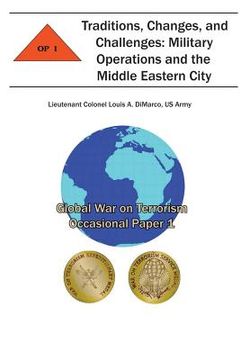Traditions, Changes and Challenges: Military Operations and the Middle Eastern City: Global War on Terrorism Occasional Paper 1 (in English)
Synopsis "Traditions, Changes and Challenges: Military Operations and the Middle Eastern City: Global War on Terrorism Occasional Paper 1 (in English)"
In July 2002 the Combat Studies Institute (CSI) was reconstituted and given a new charter by the US Army Training and Doctrine Command (TRADOC) commander, General John Abrams. One of the three missions outlined in that charter is to conduct original, interpretive research on historical topics pertinent to the current doctrinal concerns of the US Army. Having published some 10 works in the intervening two years, CSI is now poised to initiate a new series addressing important facets of the Global War on Terrorism. Lieutenant Colonel Louis DiMarco's Traditions, Changes, and Challenges: Military Operations and the Middle Eastern City is the first in that series called Occasional Papers. The Middle East is one of the most urbanized regions of the world, and growth continues at an unprecedented rate. With operations ongoing in the Middle East today, it is fitting that this inaugural study should focus on military aspects of the urban areas of that region. There is an undoubted need for US military planners to possess a solid foundation of military history, cultural awareness, and an understanding of the intricacies of city design and function in this critical region. Each conflict brings its own challenges and dynamics. The challenges of a Middle Eastern fight require decisive involvement in that region's cities. The enemy is adaptive-we must be adaptive as well. This call to study and understand history and culture is the first step along that road to critical thinking and adaptability. The purpose of this work is to examine the major features of the Middle Eastern city and evaluate the military significance of those features. It intends to serve as a starting point for military professionals, particularly commanders and key staff officers at the Army battalion through corps level, planning or conducting operations in the region. This study should provide the context within which more detailed study, evaluation, and observation can be conducted. Although this study is mindful of the ongoing Operation IRAQI FREEDOM (OIF) fight, it was initiated before OIF began and does not specifically reflect its area of operations or lessons learned. This study emphasizes the traditional aspects of the Middle Eastern city because those features are most unique and distinct from western European and North American city design with which military professionals are familiar. In addition, the old city core is often the center of religious activity and thus is disproportionately politically and socially influential. The physical aspects of the traditional Middle Eastern city are examined here in detail-mosques, suqs, residences, and quarters. Also examined in some depth is the less obvious relationship between the Islamic religion and the Middle Eastern urban environment. How the modern Middle Eastern city has changed from its traditional form and the challenges associated with that rapid change are also covered in this study. These facets of the old Middle Eastern city are examined by reference to contemporary travel guides; academic works in the fields of Middle East history, urban geography, history, architecture, and city design; appropriate military manuals and publications; and contemporary travel narratives. This work connects the description of Middle Eastern city design to the conduct of full-spectrum military urban operations. It does this through referencing American and Israeli urban warfare experts, current Army and Joint doctrine described in US Army Field Manual 3-06, Urban Operations and Joint Publication 3-06, Joint Urban Operations, other relevant official publications, and historical experiences. Although the author did conduct limited travel in some of the region's urban centers, circumstances require that this paper primarily rely on open-source research. Finally, the reader should understand that this work is a survey of general regional characteristics.

